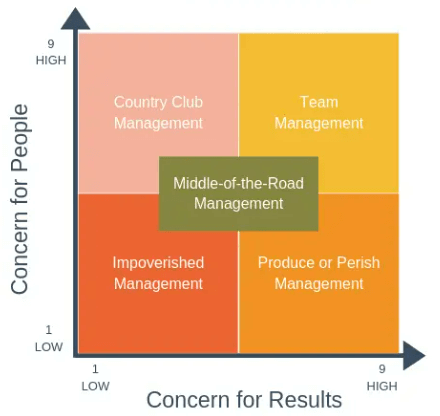Blake Mouton Grid: 5 Leadership Types for People and Production
Blake Mouton grid proposes five different leadership styles based on the concern for people and the concern for production. The managerial grid model or managerial grid theory is a style leadership model developed by Robert R. Blake and Jane Mouton. We will explain the Blake and Mouton grid, give examples for each leadership style, and provide steps for applying the Blake Mouton grid leadership styles.
In this article
📌 Hint: Do not skip this article, you will find FREE Leadership Training resources throughout the article.
What Is the Blake Mouton Grid?
Robert R. Blake and Jane Mouton are the founders of the Blake Mouton model. The inception of the model dates back to 1964. The original model defines leadership in five different leadership styles based on two dimensions: concern for people and concern for the production or results. You can see the Blake and Mouton grid and five different leadership styles in the figure below.

As you can see in the figure, one dimension shows the manager’s or leader’s degree of task, production, or result-centeredness and the other dimension shows the person-centeredness. Each dimension is scored from one to nine. And, depending on the scores of these two dimensions, appropriate leadership among these five types is determined.
Dimension #1 – Concern for People
This degree of the Blake Mouton Model shows the leader’s concerns for their followers. For instance, if the leader is too interested in the needs, self-interests, and demands of individuals, such as a servant leader, the degree of concern for people will be high, e.g. nine. If the leader is just focusing on the tasks to be accomplished and does not give that much importance to people, morale and motivation, such as an autocratic leader, the degree of concern for people will be low, e.g. one.
Dimension #2 – Concern for Tasks, Production or Results
This dimension of the Blake Mouton Model shows the degree to of a leader emphasizes concrete objectives, organizational efficiency, and high productivity when deciding how best to accomplish a task. If the leader is too much worried and concerned about the production, the degree of concern for the results will be high, e.g. nine. Adversely, if the leader is not interested in the results, the degree of concern for the results will be low, e.g. one.
Based on the degree of concern for people and concern for results (tasks or production), the appropriate leadership style is determined. Considering the five different types of leadership styles, adaptive leadership skills may be required to apply Blake Mouton’s model leadership styles.
Enhance Your Leadership Skills – Executive Leadership Training Program
San Francisco Business School offers an online, self-paced comprehensive executive leadership training program. You can consider enrolling in this program to improve your HR leadership skills.
5 Types of Leadership in Blake Mouton Grid
Now, let’s examine the five different types of leadership in the Blake Mouton Grid.
1. Impoverished Management – Low Results/Low People
Concern for the people and results are at the lowest level in this leadership style. An impoverished leader or manager is not effective. These types of leaders do not care about their team’s motivation and morale. They are not interested in creating an environment for better results as well. This style of leadership causes dissatisfaction, low morale, and poor results.
2. Produce-or-Perish Management – High Results/Low People
Leaders falling into this category of the Blake and Mouton grid typically demonstrate authoritarian leadership. For these types of leaders, the results are important. The morale, motivation, and needs of the people are always secondary to its productivity. Autocratic leaders apply strict rules and policies, reward overperformance and punish poor performance. The ultimate success for them is the output of the work performed.
This type of leadership might work on inexperienced and junior team members, however, talents and high performers will not like this approach. They value that their ideas are taken into account, and they want to feel that they are important to the organization. Therefore, this type of leadership will struggle with staff turnover.
3. Middle-of-the-Road Management – Medium Results/Medium People
As the name refers, leaders falling into this category of the Blake Mouton Grid try to balance the needs of the people versus the results. However, this strategy is not effective at all. Because this type of leadership compromises both performance and people’s motivation. The poor result in two dimensions will be inevitable.
4. Country Club Management – High People/Low Results
The Country Club Management style focuses on the team members’ morale, motivation, and happiness. This style supports that if the people are motivated, they will produce better results and they do not focus on the results a lot. Country Club leadership style is very similar to the laissez-faire leadership style.
This style of Blake Mouton leadership may create a relaxed work environment and can cause poor productivity because of missing control and direction. If the people in the team are motivated and experienced, this style can produce better results.
5. Team Management – High Production/High People
Team Management is the best leadership model according to the Blake Mouton Model. Great leaders focus on the results as well as the motivation of the people. The leader does their best to improve the work environment which will help to produce the best results and is interested in the commitment and morale of the people as well.
Team managers or leaders focus on the mission and vision of the company, motivate their followers, and do their best for the people to produce great results. These leaders are inspiring their followers and a role model for the others in the organization. They show the traits of a charismatic leader. People under the management of these kinds of leaders feel respected, valued, and committed to achieving their goals.
Team managers apply participative leadership skills. They value both the organization’s needs and the people’s interests. When making decisions, they involve their team to maximize the team buy-in to reach the goals of the organization.
When people are committed to and have a stake in, the organization’s success, their needs and production needs coincide. This creates an environment based on trust and respect, which leads to high satisfaction, motivation, and excellent results.
Two More Models for Blake and Mouton Grid
After Mouton died in 1987, Blake and his colleagues evolved the model and added two more leadership styles. However, these do not appear in the Blake and Mouton Grid.
Paternalistic Management
A Paternalistic leadership style will be somewhere between Country Club and Produce-or-Perish styles. This type of leader is supportive and authoritative as well. They support their team and encourage team members to produce the best results, however, they will not compromise from their own position. These types of leaders do not like questions and want their orders to be followed without any questions.
Opportunistic Management
There is nowhere to place this leadership style in the grid. The self-interests of the leader are the primary concern in this type of leadership. They can apply any of the five leadership styles depending on the situations that will produce the best results for the leader him/herself. They will not hesitate to take advantage of others to acquire what they want and they can be manipulative.
Free Online Leadership Skills Training Program
One of the requirements to be a good leader is to improve yourself continuously. The best way to do this is, to enhance your competence through training. Take a step ahead and jumpstart your leadership competence. Enroll in our 1-hour Free Leadership Training program.
Blake Mouton Examples for 5 Leadership Styles
Now, let’s go through some fictitious scenarios to understand the five different leadership styles of the Blake Mouton Model.
1- Impoverished Manager – Rick
Rick is working in a logistics company and he manages a team of 8 people. He has been working for the company for more than 15 years and he was promoted to his managerial role 8 years ago. Since then, he could not improve his leadership skills and other functional competencies, so he could not climb the ladder in the organization. Since he could not advance his career, he is not happy and not motivated.
Rick manages his team in a way that he assigns the tasks and does not follow the outputs. When his team needs support, he does not provide sufficient help for them. He does not monitor the results as well and there are late deliveries and complaints about his department.
2- Produce or Perish Leader – Jane
Jane is a software development manager at an IT company. She follows bureaucratic leadership practices, orders her team, and expects them to do with no or minimum questions asked. She focuses on the results of the team’s work and closely monitors the outputs. For her, the best performance metric is the output produced. She uses rewards and punishments to reward overperformance and punish poor performance.
Jane is not a believer in developing rapport with the team. She just focuses on the results. Her team members define her as a workaholic and not an empathetic leader.
3- Middle of the Road Manager – Bruce
Bruce is the manager of an HR leadership team. He is moderately focused on the results of his team and also the interest of the people in his team. Sometimes, his team members are motivated and sometimes they lose track. This reflects the results of the team as well. Sometimes the results are good while sometimes are below average.
Bruce’s team members define Bruce as an undetermined manager. Because they are not clear on the goals and objectives. They feel misled and their morale and motivation are wavy.
4- Country Club Leader – Lorene
Lorene is leading a financial firm. She has a high-asset client portfolio and their target is to provide the maximum return for their clients. Lorene hires the talents and best skilled financial analysts and she just shows them the targets. She does not step into how they manage it and she does not intervene if there are failures in their journey. She supports them when they need it, however, most of the time, the employees are on their own.
This laissez-faire leadership style of Lorene works for motivated and senior members of her team. However, less motivated people especially less experienced team members show a lack of discipline and are misguided.
5- Team Manager – Steve
Steve is a Global Leader in a multi-national automotive company. He manages thousands of people in different countries. Steve closely monitors his teams’ results and their morale and motivation as well. He tries to get every opinion from the people in his team in the decision-making process. For Steve, the commitment of the people in his team is important. He applies an open-door policy and allows anyone in the hierarchy to communicate with him directly. Whenever his team needs his support and guidance, he is with them and he closely monitors the progress of the work produced.
Watch Blake Mouton Leadership Styles YouTube Video
We have a 10-minute video describing the Blake Mouton Model. Watch now!

3 Steps to Apply Blake and Mouton Leadership Grid
When you look at the Blake Mouton Grid, it is obvious that “Team Manager” is the desired level to be reached. The first step to reach that level is to understand your characteristics and leadership style.
Step One: Identify Your Leadership Style
You can read our 15 types of leadership article and have an idea of different leadership styles.
- List the situations where you performed as a leader. Depending on the situation and workplace environment, you might have applied different leadership styles.
- Place yourself in the Blake Mouton Grid for each situation. How did you reach in each situation? Try to place leadership style in the grid for each leadership situation you performed.
Step Two: Identify Areas Where You Can Improve and Develop Your Leadership Skills
Now, assess your current leadership style. Are you a Country Club Manager or a Middle of the Road Manager? Analyze the workplace environment and culture as well. For instance, in an authoritative culture, it might not be possible to apply a Country Club leadership style.
If you feel that you are too task-oriented, then you can try to involve your team members in creative problem-solving, improve how you communicate with them or work on your mentoring skills. Or, if you tend to focus too much on people, it may mean becoming clearer about scheduling and monitoring project progress or improving your decision-making. Continually monitor your performance and watch for situations where you slip back into bad old habits.
Step Three: Put the Blake Mouton Grid in Context
The Team Management style is often the most effective approach, but some situations call for more attention to one area than the other. For example, if your company is in the middle of a merger or some other significant change, then it can be acceptable to place a higher emphasis on people than on production, to guide them and reassure them through a potentially difficult time.
Likewise, when faced with an emergency, an economic hardship, or a physical risk, concerns about people may be put to one side, for the short term at least, to achieve good results and efficiency.
Drawbacks of the Blake Mouton Grid
Blake Mouton model dates back to more than 50 years ago. Since then, leadership theories evolved a lot. In particular, the context in which leadership occurs is seen as an important driver of leadership style. In many situations, the Team Manager as an ideal has shifted towards the “Transformational Leader.”
So, the Blake Mouton Managerial Grid provides us a model for identifying and analyzing our basic leadership style. However, it is not a must to follow the model. Lots of other models evolved over time such as situational leadership by Hersey and Blanchard. There are various tools and approaches to leadership, the important thing is to find the right one for your situation to maximize the motivation and outputs.
Summary
Blake Mouton Grid was developed by Robert R. Blake and Jane Mouton in the 1960s and focuses on five different leadership styles based on the leader’s concern for people and results. The ideal stage to reach is “Team Manager” in this model. In the team manager leadership style, the leader is concerned about the people’s motivation and morale as well as the results of the work.
Although the model is useful for analyzing different types of leadership styles, it dates back to more than half a century ago. There are other leadership models evolved since then. The important point is, that leaders should use these models to assess their situation and apply the best leadership style.

